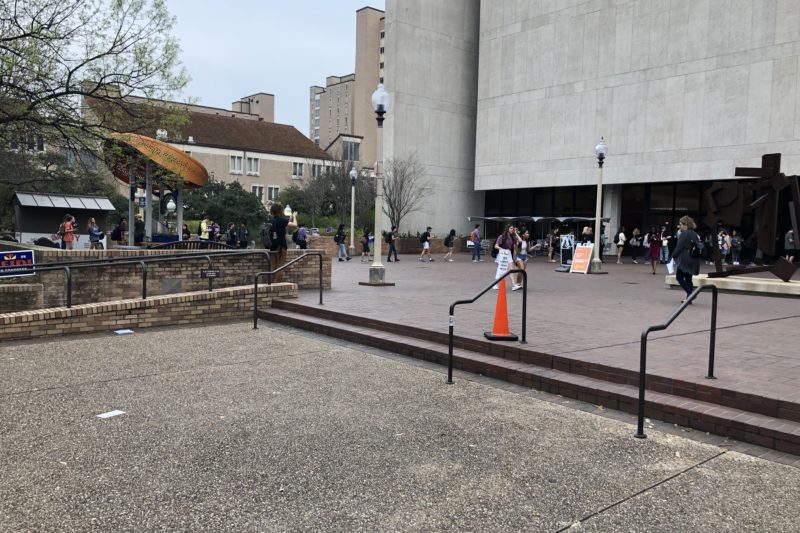Presidential Politics Dominated Forty Acres Before Pandemic
By Samantha Hall
Reporting Texas

Before a global pandemic pierced mosts Americans’ imaginations, the nation wondered if the youth vote, including students at the University of Texas, would turn out for the presidential election.
With this backdrop, for the first time in decades, Texas had a major voice in determining the Democratic nominee. And in typical fashion, Travis County took a different, more progressive path, than most of the state in “feeling the Bern.”
While the state as a whole declared Joe Biden, the former vice president, the Democratic Primary winner, Vermont Sen. Bernie Sanders won the hearts and minds of Travis County voters.
Sanders took the county with an almost 14% lead. One reason for this victory may seem unlikely: younger voters making their voices heard.
According to Kassie Phebillo, program coordinator for the non-partisan organization TX Votes, early voting at the University of Texas-based Flawn Academic Center polling location alone saw an increase of around 3,300 ballots compared to early voting at this location in the 2016 primary.
The polling site, Phebillo said, was the busiest polling location in Travis County on this year’s Election Day. In addition to this, the number of students who came out to vote on the last day of early voting doubled turnout for the last day of early voting in the 2016 primary and was higher than the 2016 general election’s busiest day of early voting.
One explanation for younger voters’ engagement may be the pervasiveness of politics today.
“I’ve heard from a lot of people that politics seems very everyday now,” TX Votes president Anthony Zhang said. “And it’s hard to tune it out even if you try.”
For others, this election screamed of its importance.
“It was crucial for me to get involved,” post-doctoral student Danya Lagos said. “It’s a matter of self-defense and people I love and care about.”
Lagos was one of many Sanders poll canvassers out on Election Day. She arrived at her polling location at 6:30 a.m. and said she wasn’t planning on leaving until the polls closed.
The term “younger voters” includes more than college-age individuals. Shannon Perri, 31, also said this election was incredibly important to her. It was so significant that, even with a baby to take care of, Perri found the time to help organize a candidate meet and greet.
“I think people in my general age bracket, and especially people even younger, are terrified about the state of the world,” Perri said. “With climate change, mounting student debt, healthcare costs, systemic racism, and so much more, it is hard not to despair. My son is eight months old. I want him to have a future of possibility. I want a future of possibility.”
But it’s not all good news from younger voters. The problem with younger voters, historically, is that they are highly undependable, according to University of Texas communications and government professor Roderick Hart.
“They tend to be issue-based voters. Issues are important to them, as opposed tophilosophy or tradition or even partisan identity,” Hart said. “If someone captures them, and Bernie did, (it’s because) he had issues that were especially attractive to younger people that drove that.”
The three big issues for younger voters are the environment, income inequality and respecting diversity, Hart said.
The Sanders platform mirrors these issues. Given the current state of the country, many voters, younger voters included, say this election is too important to skip.
Because of their perspective of this election, many younger voters were engagedlong before casting their ballots. Zhang, for example, became a member of TX Votes two years ago and is a volunteer deputy registrar. During his time as a member, he has worked to encourage people to register to vote and participate in elections, but the 2020 primary was the first presidential election in which he was eligible to vote.
One way members encourage students to register and to vote is by visiting classrooms. Zhang said he’s visited several classrooms to do this, and in the past two years he estimates he has registered 1,300-1,400 voters. In addition to this, TX Votes itself now has the highest number of members in its history.
Another all-day canvasser, Parisa Mahmud, said she’s worked to encourage people to, first, register to vote. She said she’s also spoken out on social media on the topic, and has seen positive engagement from doing so.
As was the case with several other Travis County polling locations, campus polling locations (the Perry-Castañeda Library, Flawn Academic Center and, new this year, the Texas Hillel Foundation) were no stranger to lines on Election Day. The line at the academic center was nearly wrapped around the building at times; the library had a two-hour wait at one point; and canvassers at the library site were even suggesting students go off-campus to different polling locations for a better wait time.
Whether this participation is reflected on Election Day in November remains to be seen. With the increasing likelihood that Biden will be the Democratic nominee, Hart questions whether younger voters will “go for Biden.”
“It’s part of the rejection syndrome of young people,” Hart said. “(They think) okay, I’m going to take my marbles and go home because I lost. We’d call that childish, and it is.”
The level of Biden’s ability to engage younger voters with a similar voracity as Sanders did will determine what younger voter turnout looks like in the fall.
“The college-age student is at a turning point in life, and that is a good and a bad thing,” Hart said. “In politics it helps and it hurts.”
Adding to that hurt certainly is the uncertainty of the pandemic and the nation’s economic and social recovery from it.